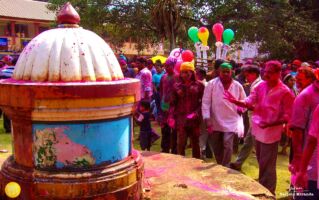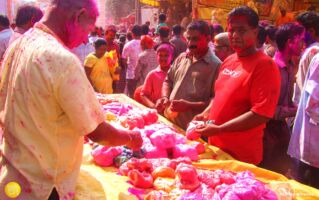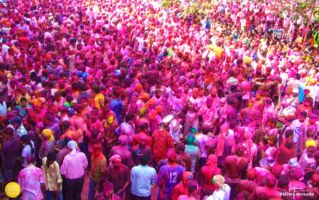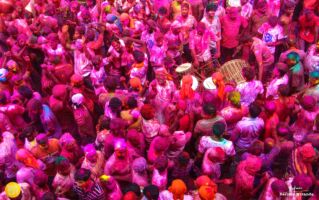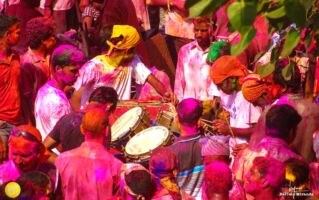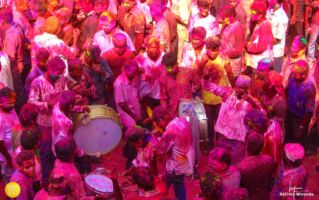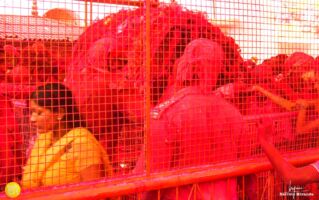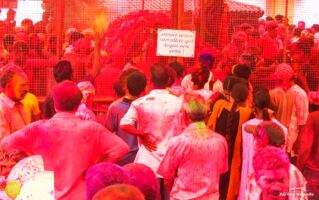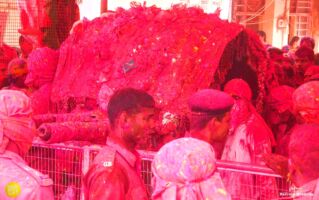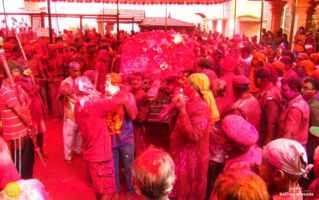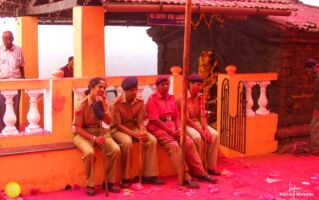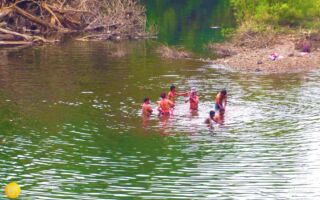Gulal at Zambaulim
Gulal is a festival connected with the Shigmo festival of Goa. It is celebrated in the month of Phalgun at the Shri Damodar Temple of Zambaulim. There are no exact records as to when the festival began. During the Portuguese regime, Christianity was introduced, sometimes by force. Hindus and Muslims were suppressed by the Portuguese, who stopped them from practicing their rituals and customs. However, the Hindus managed to continue practicing their rituals in spite of the ban.
The Portuguese destroyed some temples, which included the temple of Shri Damodar in Margao. The devotees tried their level best to take the idol of Damodar away but it was not possible to shift the entire linga, so they carried only part of the top to Zambaulim, in Sanguem, where a new temple was built and the linga installed in the garbhakudd (special sacred room) there. Earlier this festival was organized by 10 families. However, since 1927 a committee called the Mutt Gram Sanstha Hindu Sabha has been formed, which is responsible for organizing this festival. Thus, with the formation of this committee, the responsibility of celebrating Gulal passed on to the people of Margao.
Mutt Gram Sanstha Hindu Sabha has a hall in Margao, which has been named ‘Shri Damodar Hall’, from where the festivity starts. The festival begins by holding a Pooja of the coconut at the house of Mr. Purshottam Keni. This tradition is observed because it is believed that when the linga was being taken from Maddel, for security reasons, it was kept overnight at the house of Mr. Keni from where it was taken early in the morning to Zambaulim.
From then on a coconut is kept at Keni’s house where devotees recite garane (prayers). On the following day, devotees take the coconut to Zambaulim accompanied by music and song. From that day the festival of Zambaulim Shigmo starts and continues to packed audience of devotees for seven days. The important days during the celebration are Sunday, Monday and Tuesday.
On Tuesday, people from other areas also attend the festival and is the main day of the festival when a mammoth crowd visits the temple. A palki with an idol of Lord Damodar is taken out in procession in the evening with people enroute throwing gulal on the idol. Those carrying the palki as well as devotees get covered with gulal and it is considered auspicious to get smeared with gulal on this occasion.
On Monday, members of the committee singing praises to the Lord with chants of ‘Govinda, jai, jai’ bring the idol of Damodar into the hall (Sabha Mandap). The following day, after gulal and having a bath in the pond called ‘panto’, which is formed by the water of Khushavati River in the temple compound, they bring the idol back into the temple. On Wednesday, in the afternoon, after dhulpet (gulal is thrown on the idol) the Shigmo is over.
On the main day commercial activities in the city of Margao come to a standstill. Shops close down their shutters since owners and devotees of Damodar go to Zambaulim to pay obeisance to the Lord. The committee provides hundreds of devotees with lunch on all days.
Article by Maria de Lourdes Bravo da Costa Rodrigues, published in the Navhind Times.
Photos by Lynn Barreto Miranda / lynn.barretomiranda.com

Scan the code for directions.

website designed by bmwebstudio
goa / ph: 9822151419



